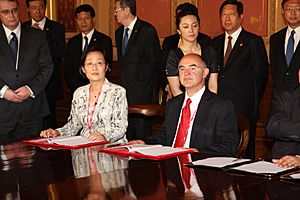Martin Sweeting facts for kids
Quick facts for kids
Sir Martin Sweeting
|
|
|---|---|

Martin Sweeting and Wu Shuang sign a Cooperation Agreement for a Remote Sensing Satellite Constellation in 2011
|
|
| Born |
Martin Nicholas Sweeting
12 March 1951 |
| Alma mater | University of Surrey |
| Awards |
|
| Scientific career | |
| Institutions |
|
| Thesis | The communications efficiency of electrically short aerials (1979) |
Sir Martin Nicholas Sweeting, born on March 12, 1951, is a famous British scientist. He is known for creating Surrey Satellite Technology Ltd (SSTL), a company that builds small satellites. SSTL started from the University of Surrey, where Sir Martin is also a special professor and leads the Surrey Space Centre.
Contents
Learning and Early Work
Sir Martin went to Aldenham School and then studied at the University of Surrey. He earned his first degree in 1974. Later, in 1979, he completed his PhD. His research was about antennas that send and receive radio signals.
Building Small Satellites
Sir Martin Sweeting is a pioneer in making small, affordable satellites. He led a team that built UoSAT-1. This was the first modern "microsatellite," weighing about 154 pounds (70 kg).
Launching UoSAT-1
In 1981, Sir Martin convinced NASA (the National Aeronautics and Space Administration) to launch UoSAT-1. It was sent into Low Earth orbit as a "piggyback" payload. This means it rode along with a larger main satellite.
Communicating with Space
UoSAT-1 and the satellites that followed used amateur radio bands. This allowed them to talk to a ground station located at the University of Surrey. This was a new and exciting way to communicate with space.
Growing the Satellite Idea
Throughout the 1980s, Sir Martin continued his research. He wanted to develop the idea of small satellites even further. He explored how they could be used for things like remote sensing. This is when satellites collect information about Earth from space. His small satellite research group grew and launched more satellites.
Creating SSTL
In 1985, this research led to the creation of Surrey Satellite Technology Ltd (SSTL). The company started with just four employees and a small amount of money. SSTL helped share space technologies with other countries. Later, in 2009, SSTL became a separate company from the University and was sold to another aerospace company.
Awards and Special Recognition
Sir Martin Sweeting has received many awards for his important work.
- In 2000, he was given the Mullard Award by the Royal Society. He also became a Fellow of the Royal Society in the same year.
- In 2002, he was knighted. This means he was given the title "Sir" for his amazing work on making spacecraft that are both effective and affordable.
- In 2006, he won an award for his work on the Disaster Monitoring Constellation (DMC). This is a group of satellites that help monitor disasters around the world.
- In 2008, he received the Gold Medal from the Royal Institute of Navigation. This was for the successful GIOVE-A mission, which was part of the European Galileo system for satellite navigation. He also received the Sir Arthur Clarke Lifetime Achievement Award.
- In 2009, he was awarded the Faraday Medal by the Institute of Engineering and Technology. He also received an Elektra Lifetime Achievement Award for his contributions to the European Electronics Industry.
- In 2014, he received an award from the Chinese Academy of Sciences.
- In 2021, he was a guest on the BBC Radio 4 program The Life Scientific.

